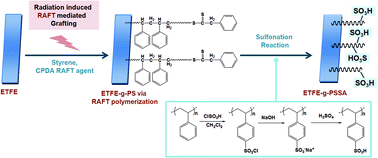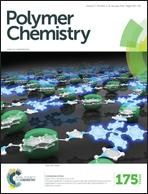Towards new proton exchange membrane materials with enhanced performance via RAFT polymerization†
Abstract
This study focuses on the synthesis of well-defined proton exchange membranes (PEM) for fuel cell applications using reversible addition–fragmentation chain transfer (RAFT) polymerization in the radiation-induced grafting part of the overall process. Novel PEMs were prepared via grafting of polystyrene (PS) from a poly(ethylene-alt-tetrafluoroethylene) (ETFE) film as a model system. The membranes with various grafting degrees were characterised by ATR-FTIR, Raman, X-ray photoelectron and positron annihilation lifetime spectroscopy, as well as SEM-EDX, AFM, TGA, DSC and DMA techniques. This extensive characterization confirmed the existence of grafted PS chains in copolymer compositions and the success of subsequent sulfonation. The number-average molecular weight and polydispersity of the non-grafted PS determined by size-exclusion chromatography (SEC) indicated a controlled polymerization in solution. SEM-EDX and AFM results implied that polymerizations were controlled also within the ETFE matrix and on its surface. The introduction of RAFT polymerization in the PEM fuel cell preparation process enhanced the structural uniformity and performance in terms of proton conductivity compared to a conventional method.


 Please wait while we load your content...
Please wait while we load your content...